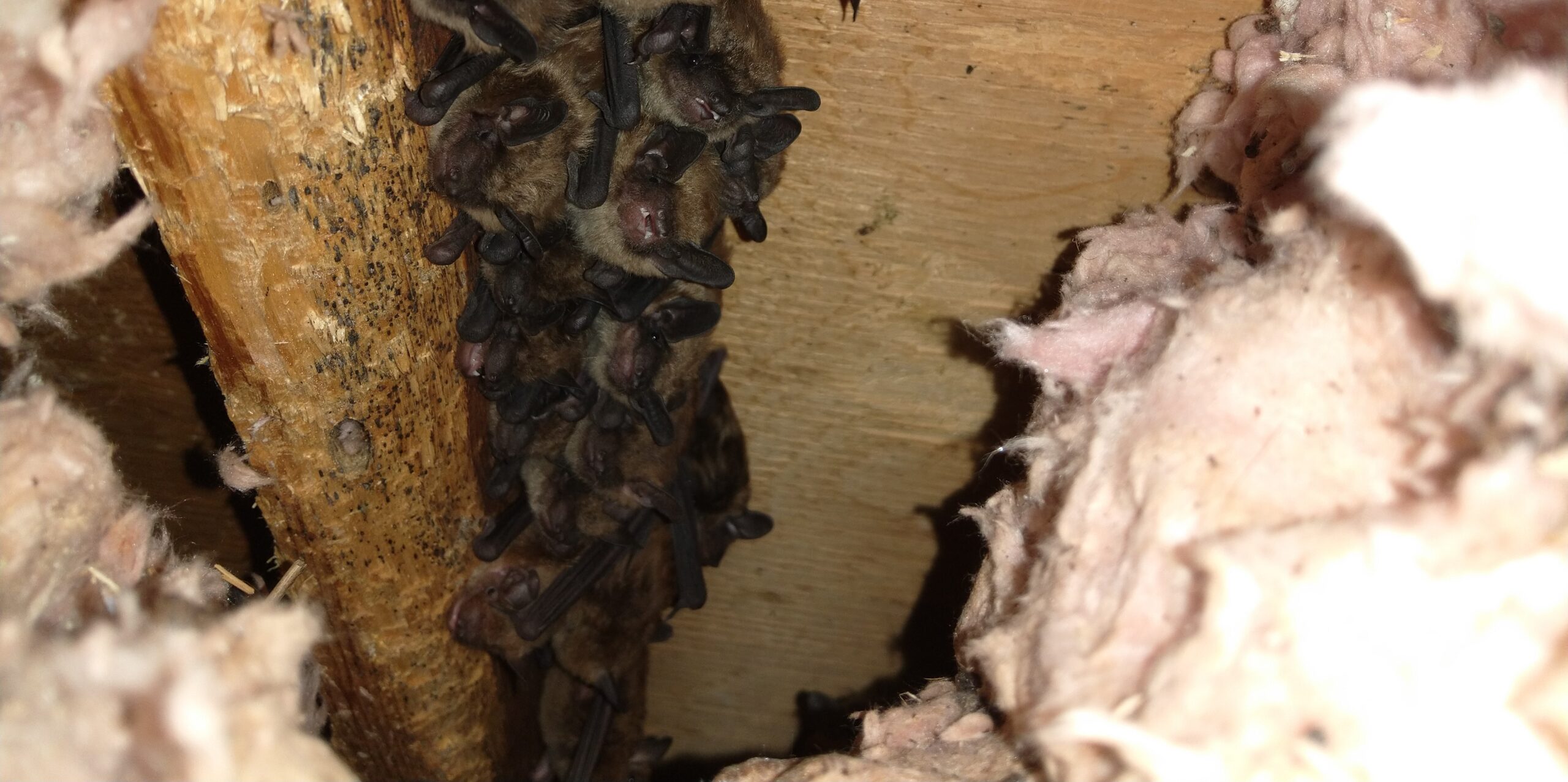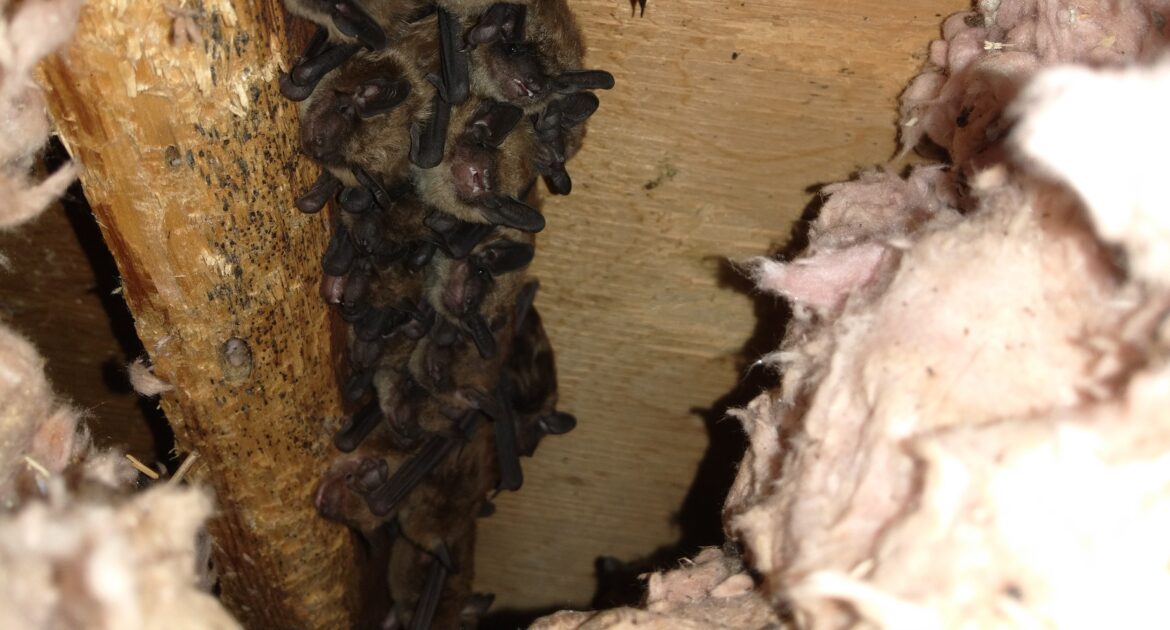Ontario health units are sounding the alarm: bat encounters in Ontario are on the rise. This summer, Peterborough Public Health, now merged with the Haliburton Kawartha Pine Ridge District Health Unit, issued a notice after a “noticeable” spike in bat-related exposures. They urged residents to “avoid handling” bats, warning that even small bites or scratches raise the rabies risk from bats.
So what should families do? Public health experts stress that public health bat safety tips must be followed, and that you should never try to capture a bat indoors yourself. Instead, confine it to one room, turn off the lights, and open a window. If that doesn’t work, call for professional help like humane bat removal in Bowmanville. At Skedaddle Humane Wildlife Control, we help families respond safely to these encounters so you can protect your loved ones.
In this article, you’ll learn why bat encounters are happening more often, the health risks you need to know, the top safety tips from public health units, and how our team can help keep your family safe.
Why Are Bat Encounters Rising in Ontario?
Experts have noticed a big jump in reported cases this year. One Ontario health unit reported a “noticeable” spike in people being exposed to bats. That means more residents are finding bats inside homes, cottages, or garages.
There are a few reasons why this is happening:
- Seasonal Behaviour: Bats move around more in the summer as they hunt for insects and find safe roosts.
- Changing Weather: Warm winters and hot summers affect insect populations. When food is harder to find, bats may explore closer to homes.
- Building Design: Many houses in Ontario have small gaps around roofs, vents, or chimneys. These create easy entry points.
The result? More families in Bowmanville and across the province are coming face to face with these flying animals inside their own homes.
Rabies Risk From Bats
The main danger linked to bats is rabies. Rabies is a deadly virus that spreads through saliva, often from a bite or scratch. While only a small percentage of bats carry rabies, health units stress that you can’t take chances.
Rabies symptoms in humans start with fever, headache, and fatigue. Once the disease progresses, it affects the brain and is almost always fatal. That’s why Ontario health officials urge people never to touch a bat. Even a small scratch you don’t notice could put you at risk.
Health officials stress three main points:
- If a bat touches you, even slightly, seek medical help right away.
- If you find a dead one, call the health unit instead of moving it yourself.
- If a bat is flying in your home, do not try to capture it.
These reminders may seem simple, but they save lives.
Public Health Safety Tips: Ontario Health Unit Warnings You Should Know
Health officials are clear: bats carry risks you can’t ignore. The recent Peterborough Public Health notice included several key points families need to remember:
- Don’t try to capture bats indoors. This raises the chance of being bitten or scratched.
- Low contact means low risk. If you find one simply flying around and doesn’t touch anyone, the rabies risk is extremely low.
- If touched, scratched, or bitten, act fast. Wash the area with soap and water (or sanitizer if no soap is available), then contact a doctor or local health unit.
- Dead bats are not safe to handle. If you find one, call the health unit for proper guidance.
- Rabies is preventable. Treatment works if you act quickly, but once symptoms appear, it is fatal.
These warnings underline why families should never try to handle a situation alone. You protect your health — and your peace of mind — by relying on experts.
Why Bats Enter Homes
You might be asking: why is this happening in my house? The truth is, bats look for safe places to rest or raise young. Unfortunately, many homes offer perfect spots.
Common entry points include:
- Gaps around rooflines and soffits
- Loose siding or vents
- Uncapped chimneys
- Open windows or doors at night
Once inside, bats may roost in attics, garages, or wall voids. For homeowners, this creates stress and raises health concerns.
How We Help Prevent Bats From Entering
Bats often look for small gaps or weak spots to sneak inside. At Skedaddle, our team focuses on the areas most likely to cause trouble and uses safe, humane methods to block access.
- Inspecting the Home: We check for holes, cracks, or gaps that animals could slip through. Even tiny openings are a concern.
- Securing Rooflines: Our technicians make sure soffits and eaves are sealed so bats can’t use them as entry points.
- Capping Chimneys and Vents: We install professional covers that stop animals from entering while still allowing airflow.
- Reducing Attractants: We assess outdoor conditions that may draw insects closer to your home, since bats follow their food sources.
By targeting these problem areas, our process makes your home far less appealing to wildlife.
What Happens If a Bat Gets Indoors
Finding a bat in your living space can feel overwhelming, but that’s exactly when Skedaddle steps in. Our team handles the situation safely from start to finish.
- Containment: We isolate the bat to keep it from moving deeper into the home.
- Humane Exit: Using our one-way doors, we allow the bat to leave on its own but prevent it from returning.
- Safety First: We never use risky handling. Our process protects both your family and the animal.
- Follow-Up Protection: After removal, we check for common entry points and secure them to stop repeat visits.
This approach keeps families safe, protects the animal, and gives you peace of mind that the problem won’t return.
Signs You May Have a Bat Problem
Sometimes families don’t realize bats are living in their home until the problem grows. Watch for these signs:
- Strange squeaking or scratching sounds at night
- Droppings that look like small black pellets in attics or garages
- Strong, musty odours that don’t go away
- Stains near entry points along the roofline
If you see any of these clues, it’s time to act. Delaying can lead to more animals moving in and bigger health risks.
Protecting Children and Families
Parents often worry most about kids. The good news is you can reduce risks by teaching children some basic safety rules:
- Never touch an unknown animal, alive or dead
- Tell an adult right away if they see a bat indoors
- Stay away from dark attic spaces or sheds without checking first
These simple habits go a long way in protecting children from bat exposure.
Humane Bat Removal in Bowmanville
When prevention isn’t enough, removal is the next step. Skedaddle Humane Wildlife Control in Bowmanville specializes in safe, humane bat removal. We use proven methods that allow bats to exit but not re-enter. Once they are gone, we seal up entry points so they can’t return.
This process protects your home, your family, and the animals. It’s a win-win solution that meets both safety and environmental goals.
Bat Encounters In Ontario—Protect Your Family Today
Ontario health units are clear: bat encounters in Ontario are on the rise. With the growing rabies risk from bats, you can’t wait until there’s a serious problem. Taking small steps now, like learning public health bat safety tips and calling experts for help, protects your home and your loved ones.
If you’re worried about bat encounters in Ontario, now is the time to act. From reducing the rabies risk from bats to following public health bat safety tips, every step matters. When bats get inside, trust the experts.
With humane bat removal in Bowmanville, our team at Skedaddle Humane Wildlife Control will help you protect your family and keep your home safe.
Request an estimate today and take the first step toward peace of mind.




